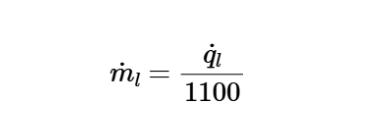1. What is a Mass Flow Rate of Water (Latent Load) Calculator?
Definition: This calculator computes the mass flow rate of water (\( \dot{m}_l \)) removed or added due to the latent heat load in an HVAC process, assuming a latent heat of vaporization of 1100 Btu/lb.
Purpose: It is used in HVAC systems to determine the amount of water condensed (dehumidification) or evaporated (humidification) based on the latent heat load, aiding in the design of moisture control systems.
2. How Does the Calculator Work?
The calculator uses the following formula for the mass flow rate of water:
Mass Flow Rate of Water:
\[
\dot{m}_l = \frac{\dot{q}_l}{1100}
\]
Where:
- \( \dot{m}_l \): Mass flow rate of water (lb/hr, convertible to kg/hr)
- \( \dot{q}_l \): Latent heat load (Btu/hr, kW)
- Constant 1100: Latent heat of vaporization (Btu/lb, approximate value for water at typical HVAC conditions)
Unit Conversions:
- Latent Heat Load (\( \dot{q}_l \)): Btu/hr, kW (1 kW = 3412.14 Btu/hr)
- Mass Flow Rate (\( \dot{m}_l \)): lb/hr, kg/hr (1 lb/hr = 0.453592 kg/hr)
Steps:
- Enter the latent heat load (\( \dot{q}_l \)) and select its unit.
- Convert the latent heat load to Btu/hr.
- Calculate the mass flow rate of water using the formula.
- Convert the result to the selected unit (lb/hr or kg/hr).
- Display the result with 5 decimal places, or in scientific notation if the value is greater than 10,000 or less than 0.00001.
3. Importance of Mass Flow Rate of Water (Latent Load) Calculation
Calculating the mass flow rate of water due to latent load is crucial for:
- HVAC Design: Determines the amount of water removed (dehumidification) or added (humidification), aiding in the sizing of equipment like dehumidifiers, humidifiers, or condensate drainage systems.
- Energy Efficiency: Helps optimize moisture control processes by ensuring the correct amount of water is managed, avoiding over- or under-humidification.
- System Performance: Ensures the system can achieve the desired humidity levels for comfort or process requirements by accurately calculating the water mass flow rate.
4. Using the Calculator
Examples:
- Example 1: For \( \dot{q}_l = 75000 \, \text{Btu/hr} \), mass flow rate in lb/hr:
- \( \dot{m}_l = \frac{75000}{1100} \)
- \( \dot{m}_l \approx 68.18182 \)
- Since 68.18182 < 10000 and > 0.00001, display with 5 decimal places: \( 68.18182 \)
- Example 2: For \( \dot{q}_l = 20 \, \text{kW} \), mass flow rate in kg/hr:
- Convert: \( \dot{q}_l = 20 \times 3412.14 = 68242.8 \, \text{Btu/hr} \)
- \( \dot{m}_l = \frac{68242.8}{1100} \approx 62.03891 \, \text{lb/hr} \)
- Convert to kg/hr: \( 62.03891 \times 0.453592 = 28.13293 \)
- Since 28.13293 < 10000 and > 0.00001, display with 5 decimal places: \( 28.13293 \)
- Example 3: For \( \dot{q}_l = 0.01 \, \text{Btu/hr} \), mass flow rate in lb/hr:
- \( \dot{m}_l = \frac{0.01}{1100} \approx 0.0000090909 \)
- Since 0.0000090909 < 0.00001, use scientific notation: \( 9.09090e-6 \)
5. Frequently Asked Questions (FAQ)
Q: What does the mass flow rate of water represent in HVAC systems?
A: The mass flow rate of water (\( \dot{m}_l \)) represents the rate at which water is removed (during dehumidification) or added (during humidification) due to the latent heat load, typically associated with moisture control in the air.
Q: Why is the constant 1100 Btu/lb used in the formula?
A: The constant 1100 Btu/lb is an approximate value for the latent heat of vaporization of water at typical HVAC conditions, representing the energy required to evaporate or condense 1 lb of water.
Q: How can I determine the latent heat load for my system?
A: The latent heat load can be calculated using psychrometric equations, measured using HVAC design software, or estimated based on humidity changes in the air stream, often derived from psychrometric charts or field measurements.
Mass Flow Rate of Water (Latent Load) Calculator© - All Rights Reserved 2025
 Home
Home
 Back
Back
